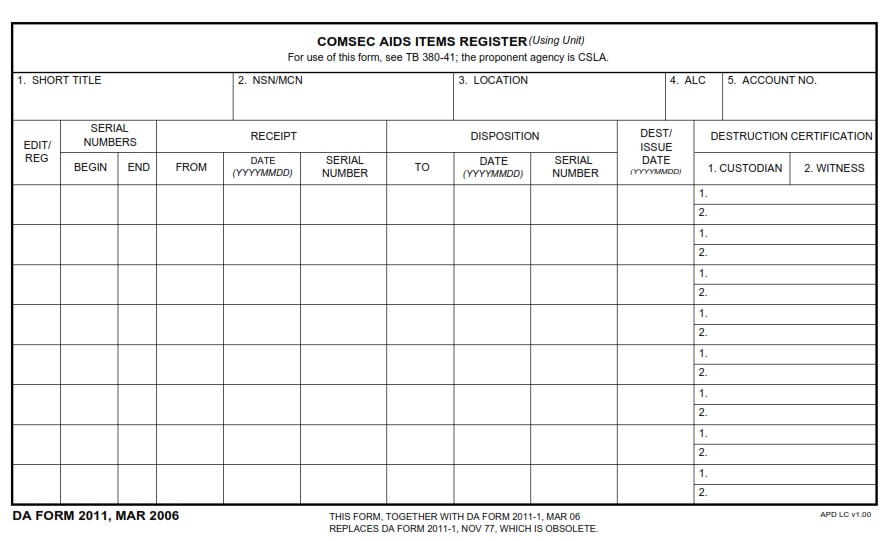Table of Contents
FREE-ONLINE-FORMS.COM – DA Form 2011 – Comsec AIDS Items Register (Using Unit) – Are you ready to dive into the world of secure communication and cryptography? Look no further than the DA Form 2011 – Comsec AIDS Items Register (Using Unit). This essential document serves as a critical tool for military units and organizations tasked with safeguarding sensitive information and maintaining secure communication channels. In today’s fast-paced, technology-driven world, the need for robust encryption and protection against unauthorized access has never been greater. The Comsec AIDS Items Register is a key component in achieving these objectives, ensuring that classified materials are properly tracked, managed, and accounted for within a unit.
Imagine being entrusted with the responsibility of safeguarding vital national security secrets or coordinating communications in high-stakes operations. The DA Form 2011 is your gateway to understanding the meticulous process of managing Communication Security (Comsec) assets within military units. From cryptographic keys to secure communication devices, this article will explore the significance of this register in upholding operational security and confidentiality at every level. Whether you’re a seasoned professional in the field or simply curious about how modern militaries protect their most sensitive information, join us on this journey through the intricacies of Comsec management using DA Form 2011.
Download DA Form 2011 – Comsec AIDS Items Register (Using Unit)
| Form Number | DA Form 2011 |
| Form Title | Comsec AIDS Items Register (Using Unit) |
| Edition Date | 3/1/2006 |
| File Size | 49 KB |
What is a DA Form 2011?
The DA Form 2011, also known as the Comsec AIDS Items Register (Using Unit), is a crucial document used by the Department of Defense to track and manage communication security (COMSEC) aids items. These items may include cryptographic materials, keying material, or any other equipment used to secure sensitive military communications. The form serves as a detailed record of all COMSEC aids items issued to a specific unit, allowing for accountability and proper management.
In addition to tracking the issuance of COMSEC items, the DA Form 2011 also plays a critical role in ensuring compliance with security protocols and regulations. By documenting the movement and use of these sensitive materials, the form helps maintain strict control over access and distribution. Furthermore, it provides an essential tool for conducting inventories and audits to verify the status and location of COMSEC aids items within a unit. Ultimately, this meticulous record-keeping is vital in safeguarding classified information and preventing unauthorized access or loss of critical assets.
Overall, understanding the significance of the DA Form 2011 in managing COMSEC aids items underscores its pivotal role in maintaining national security. It represents more than just bureaucratic paperwork; it symbolizes the commitment to upholding stringent security measures and protecting valuable intelligence assets from potential threats. As technology continues to advance rapidly, leveraging such meticulous documentation becomes increasingly imperative in mitigating risks associated with unauthorized disclosure or exploitation of classified information.
Where Can I Find a DA Form 2011?
The DA Form 2011, also known as the Comsec AIDS Items Register (Using Unit), is a crucial document used by military personnel to maintain accountability for communication security (COMSEC) materials. This form serves as a record-keeping tool for tracking the distribution and use of sensitive COMSEC items within a unit, ensuring that they are properly safeguarded and accounted for. So where can you find this important form? The DA Form 2011 can typically be obtained through official military channels such as unit supply offices, logistics departments, or online databases managed by the Department of Defense.
In addition to traditional avenues, there are digital resources that provide access to various military forms including the DA Form 2011. Many official military websites offer downloadable PDF versions of these documents, allowing authorized personnel to easily access and complete them as needed. It’s important for service members to familiarize themselves with the proper procedures for obtaining and using the DA Form 2011 in order to fulfill their responsibilities in maintaining COMSEC accountability. By understanding where and how to find this form, individuals can contribute to upholding essential security protocols within their units while also streamlining administrative processes related to COMSEC materials management.
DA Form 2011 – Comsec AIDS Items Register (Using Unit)
The DA Form 2011, also known as the Comsec AIDS Items Register (Using Unit), plays a crucial role in maintaining security and accountability within military communications. This form serves as a comprehensive record of all communications security (COMSEC) aids and items used by military units, ensuring that all sensitive materials are properly tracked and managed. By meticulously documenting the issuance and return of COMSEC materials, the form helps prevent unauthorized access and loss of critical information.
Moreover, the meticulous nature of the DA Form 2011 reflects the high standards set for safeguarding sensitive data in modern warfare. As technology continues to advance, the need for rigorous COMSEC measures becomes increasingly vital to national security. The thorough documentation required by this form demonstrates a commitment to upholding these standards and fostering a culture of responsibility when handling classified information.
The DA Form 2011 – Comsec AIDS Items Register (Using Unit) represents more than just administrative paperwork; it symbolizes a dedication to maintaining operational security in an ever-evolving digital landscape. Understanding its importance not only highlights the complexity of modern military operations but also underscores the unwavering commitment to protecting sensitive information from potential threats.
